MilchTaxi
Bequeme Eimerfütterung: Der mobile Milchtank ermöglicht eine individuelle Kälberfütterung durch Boxenerkennung, flexible Futterkurven, TS-Berechnung.
Eimerfütterung leicht gemacht: Komfortabel und schnell Kälber füttern, mit Spaß bei der Arbeit.
Futterkosten sparen dank Vollmilch-Pasteurisierung und Einsatz individueller Futterkurven.
Gesunde Kälber durch exakte, ausgeglichene Futterzubereitung und Tank- und Eimerreinigung.
Mobile Kälberfütterung – durchdacht bis ins Detail
Das MilchTaxi hat die Eimerfütterung der Kälber revolutioniert. Ob einzeln in Kälberiglus oder gruppenweise im Kälberstall, das MilchTaxi füttert Ihre Kälber, wo immer sie sind. Sie können Milchpulver zuverlässig aufrühren und Vollmilch schonend erwärmen oder pasteurisieren.
Endlich müssen Sie keine schweren Eimer mehr schleppen. Das wendige Fahrwerk übernimmt den Transport zu den Kälberboxen für Sie. Doch das MilchTaxi erleichtert nicht nur Ihre Arbeit. Es macht die Fütterung genauer, weil Sie Ihren Kälbern immer die richtige Menge mit der richtigen Temperatur füttern.
Das MilchTaxi hat im Laufe der Zeit immer neue Funktionen erhalten. So können Sie jetzt u.a. sogar Futterkurven hinterlegen (SmartID), mit denen die Kälber langsam und schonend abgetränkt werden. Die Anbindung an das Managementsystem CalfGuide gibt Ihnen die absolute Kontrolle über die Arbeitsabläufe im Kälberstall und ermöglicht eine detaillierte Dokumentation der Zubereitung und Fütterung der Kälbermilch.
Und ganz nebenbei macht das Füttern mit dem MilchTaxi richtig Spaß!
Unsere sechs Modelle
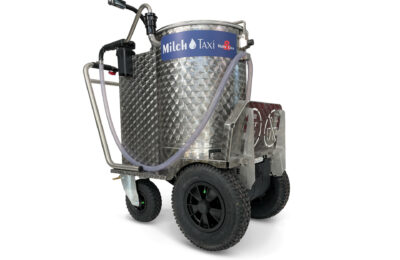
MilchTaxi 100 l
Für bis zu 20 Kälber oder 200 Liter Tränke/Tag, optional mit Pasteur
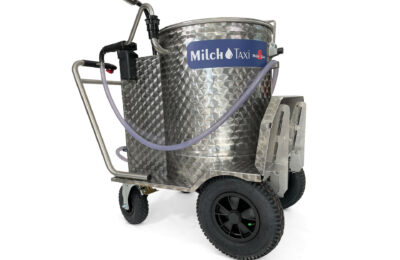
MilchTaxi 150 l
Für bis zu 30 Kälber oder 300 Liter Tränke/Tag, optional mit Pasteur
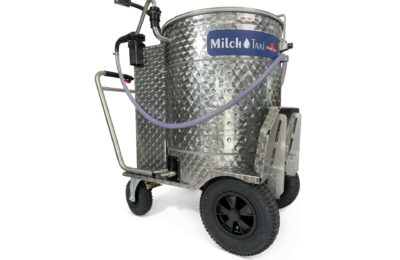
MilchTaxi 260 l
Für bis zu 50 Kälber oder 500 Liter Tränke/Tag, optional mit Pasteur
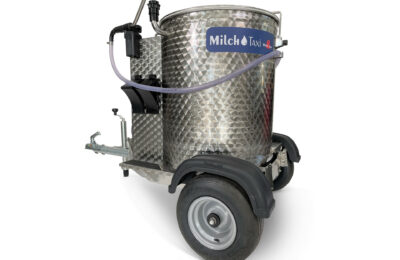
MilchTaxi 260 l Anhänger
Für bis zu 50 Kälber oder 500 Liter Tränke/Tag als Anhängegerät, optional mit Pasteur
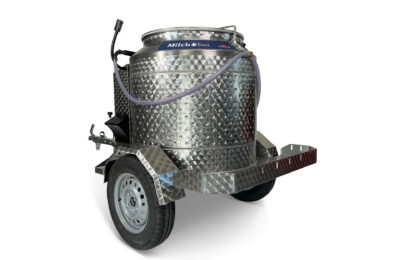
MilchTaxi 400 l Anhänger
Für bis zu 80 Kälber oder 800 Liter Tränke/Tag als Anhängegerät, optional mit Pasteur
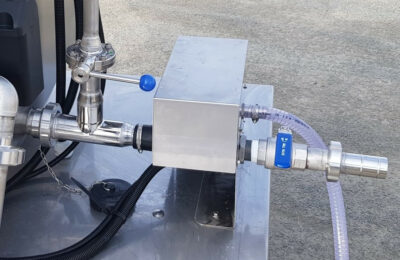
Dosiereinheit MilchTaxi XXL
Pumpen- und Steuereinheit für die Montage um andere Tanks zum MilchTaxi XXL umzuwandeln.
Viele Stärken des MilchTaxis liegen ein wenig im Verborgenen: Wie es Milchpulver in Sekunden klumpenfrei aufrührt oder Vollmilch schonend erwärmt, ohne dass sie anbrennt, überrascht jeden, der das MilchTaxi das erste Mal sieht.
Kraftvolles Bodenrührwerk
Das 250 Watt Rührwerk mischt in Sekunden jeden Milchaustauscher klumpenfrei auf. Zudem unterstützt das Rührwerk die Heizung durch kurze Mischintervalle. Wichtig: Diese Intervalle sind an die Milchmenge angepasst. Durch die Montage im Boden ist maximale Arbeitssicherheit gegeben und nichts stört beim Reinigen des Tanks.
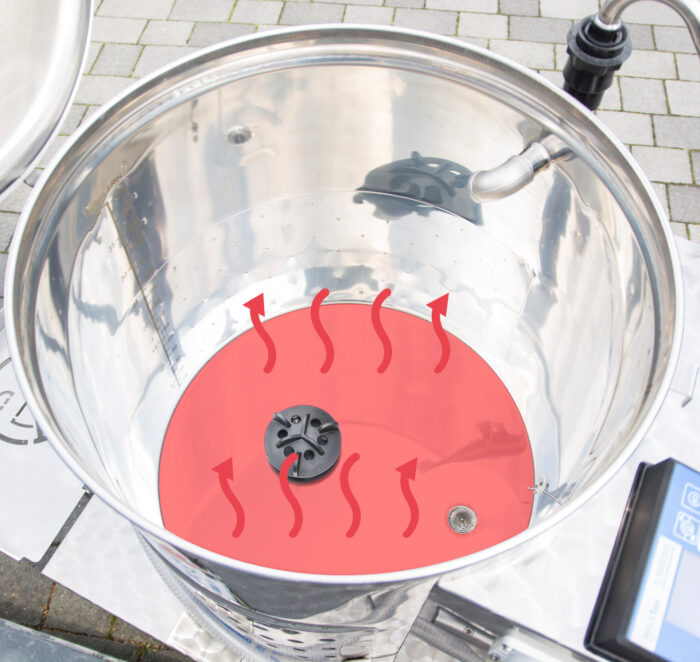
Schonende Heizung
Das MilchTaxi arbeitet mit einer Flächenheizung über die komplette Bodenfläche. Anders als bei Spiralheizungen entstehen so keine „hotspots“, an denen die Milch anbrennen kann. Somit wird die Milch schnell erwärmt und die Qualität bleibt trotzdem erhalten. Das Display informiert Sie immer über die aktuelle Temperatur Ihrer Tränke.
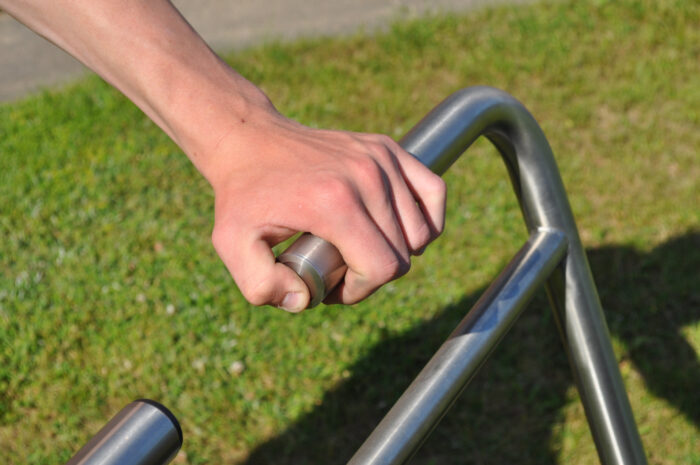
Einfaches Ausdosieren
Mit 9 frei programmierbaren Dosierstufen können Sie fast jede beliebige Futtermenge ausdosieren – ohne lästiges Nachtropfen. Zudem ist der Griff ergonomisch angepasst und schön leicht. Dank der integrierten Batterie sind Sie bei den Kälbern von der Stromversorgung unabhängig. So sind Sie besonders bei der Einzeligluhaltung völlig flexibel in der Standortwahl und können Kälber auch an verschiedenen Orten füttern.
Das leichte Transportieren der Milch ist eine entscheidende Arbeitserleichterung. Vier standsichere Räder und der elektrische Fahrantrieb sorgen immer für gute Fahrt.
EL-AN Fahrantrieb
Bei allen Modellen können Sie mit dem elektrischen Fahrantrieb stufenlos in zwei Geschwindigkeiten vorwärts und rückwärts fahren. So macht das Kälberfüttern nicht nur Spaß, sondern schont auch Ihren Rücken.
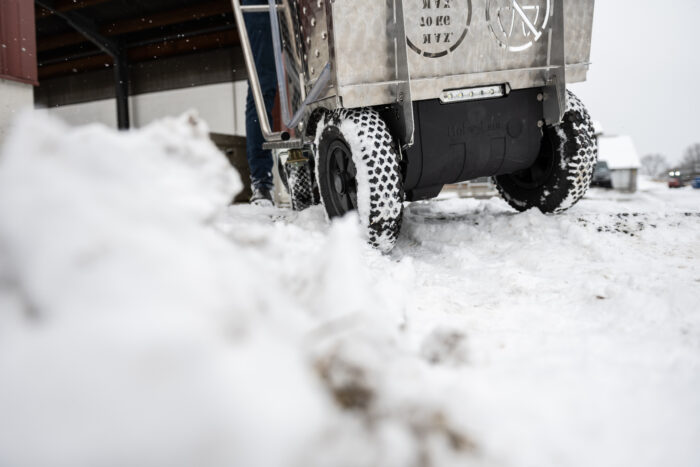
Standsicheres 4-Rad Fahrwerk
Auf 4 Rädern mit niedrigem Schwerpunkt ist das MilchTaxi extrem standsicher. Auch bei schneller Fahrt, unebenem Boden und voll gefüllt kippt es nicht um. Mit den 40 cm großen Vorderrädern und der großen Bodenfreiheit sind Unebenheiten oder kleine Schwellen kein Hindernis. Alternativ ist das Model 260 l auch als Anhängewagen mit einer Achse erhältlich.
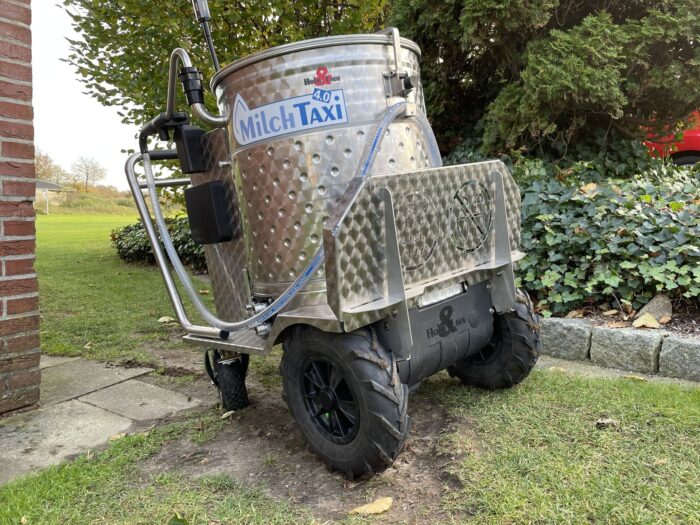
Stollenreifen
Das MilchTaxi kann optional mit Traktorstollenprofil auf den Frontreifen ausgestattet werden. Diese Option kann für Betriebe sinnvoll sein, auf denen sehr weicher oder gar matschiger Untergrund auf dem Weg zu den Kälbern überwunden werden muss. Das Profil sorgt für besseren Grip und ein zügiges Fortkommen bei schwierigen Bedingungen. Wie bei der normalen Bereifung sind auch diese Stollenreifen als Luftbereifung oder auf Wunsch mit pannensicherer Gummifüllung erhältlich.
Bedienerfreundliches Display, leichte Reinigung, die Möglichkeit, mit dem MilchTaxi auch die Nuckeleimer reinigen zu können: Sie werden Ihr MilchTaxi nicht mehr missen wollen.

Funkfernbedienung
Mit der Fernbedienung am Dosierarm können Sie bequem auch die Kälber füttern, die bis zu 10 m vom MilchTaxi entfernt stehen, ganz ohne Kabel. Selbstverständlich können auch hier die Mengen am Dosierarm individuell angepasst werden.
Dunkelheit? Kein Problem
Dank des integrierten LED Fahrlichts sehen Sie immer, wohin Sie fahren. Dann ist das Kälberfüttern auch in entfernter gelegenen Kälberhütten abends kein Problem.
Zusätzlich bringt das neue oben montierte SpotLight Licht ins Dunkel: Der absolut flexible Schwanenhals sorgt für einen 360° Rundumblick auf Arbeitshöhe.
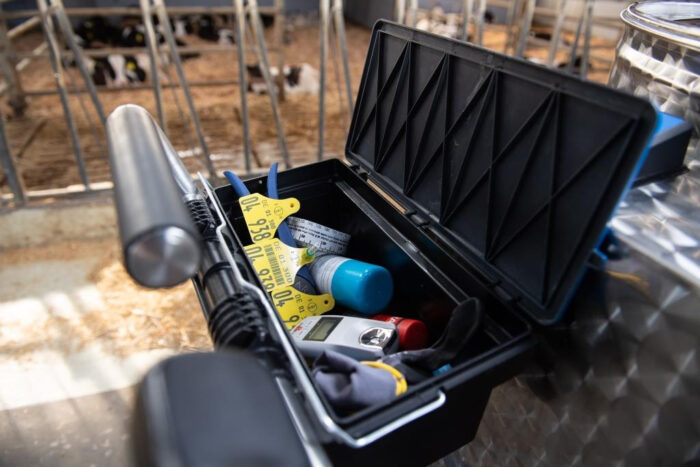
Handschuhfach - für kleine und große Helfer
Die praktische Aufbewahrungsbox bietet Platz für alle kleinen Hilfsmittel, die im Kälberstall benötigt werden. Ob Ohrmarkenzange, Thermometer, Gewichtsmaßband, Einmalhandschuhe, Stalllisten oder andere wichtige Dinge, alles findet seinen Platz im praktischen Handschuhfach. Zudem ist der gerade Deckel hervorragend als Schreibunterlage geeignet. Da man die gesamte Box sehr einfach vom MilchTaxi lösen und transportieren kann, sind diese Dinge auch an allen anderen Orten schnell zur Hand.
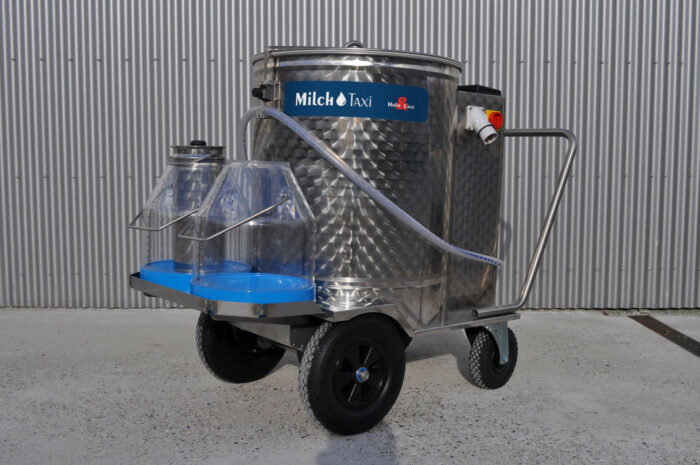
Eimertransport
Besonders praktisch ist der Klapprahmen, auf dem Sie bis zu zwei Milchkannen transportieren können. Aber auch andere Dinge lassen sich so leicht transportieren, wie Trockenfutter oder Werkzeug. Besonders praktisch sind die 8 l Biestmilchkannen. In die größere Kanne mit warmem Wasser gesteckt, bleibt die Milch optimal temperiert, bevor sie an die Kälber verfüttert wird.
PlusTank

Präzisionsfütterung via MilchTaxi
Der PlusTank ist eine ideale Ergänzung zum MilchTaxi-System. Mit ihm lassen sich (zusätzlich zur normalen Milch) bis zu 60 Liter extra Milch transportieren. Zum Beispiel das besonders wertvolle Kolostrum oder die Transitmilch. So wird sichergestellt, dass Kälber individuell und nach ihren eigenen Bedürfnissen versorgt werden können.
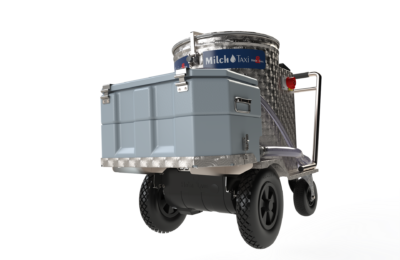
Präzise Zusatzmischungen
Der PlusTank bietet die Möglichkeit, eine spezielle Zusatzmischung im Haupttank vorzubereiten und auf die optimale Temperatur zu bringen. Dann wird sie in den PlusTank umgefüllt. Durch eine direkte Verbindung zur Dosierpumpe des MilchTaxis lässt sich die zusätzliche Milch präzise ausdosieren, was eine auf das einzelne Kalb abgestimmte Fütterung ermöglicht.
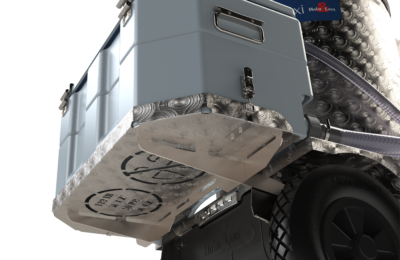
Multitalent für Modelle ab 2015
Der PlusTank überzeugt durch seine Multifunktionalität. So kann er nach dem Tränken überschüssige Milch einsammeln, Drenchlösungen für Kühe bevorraten oder Spül- und Tränkwasser transportieren. Er ist kompatibel mit allen MilchTaxis 3.0 und 4.0 der Größen 150 und 260 Liter ab dem Baujahr 2015.
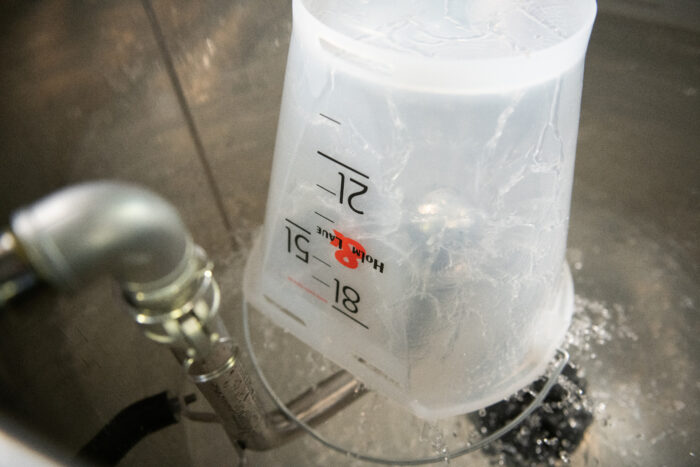
FlushMaster Eimerreinigung
Das Reinigen der Tränkeeimer ist zeitaufwendig, da man die Eimer einsammeln und zum Waschplatz transportieren muss. Mit dem FlushMaster reinigen Sie die Eimer mit einer rotierenden Düse im MilchTaxi, direkt an der Kälberhütte. Dieses praktische Hilfsmittel ist nachrüstbar für alle MilchTaxi Modelle mit Pumpe.
Einfache Reinigung
Da der Deckel komplett geöffnet werden kann, fällt die Reinigung des Behälters sehr leicht. Das halbautomatische Reinigungsprogramm sorgt für eine optimale Hygiene. Restmengen, auch aus Pumpe und Schlauch, können vollständig entleert werden. Eine ergänzende Reinigung mit der Bürste verbessert das Ergebnis und nach wenigen Minuten ist Ihr MilchTaxi wieder einsatzbereit.
Als zusätzliche Möglichkeit ist auch der FlushMaster ideal für die gründliche Tankreinigung geeignet und hinterlässt ein sauberes Innenleben vom Deckel bis zum Boden.
Statistikfunktion
Im Displaymenü des MilchTaxi können Sie die wichtigsten Arbeitsschritte über eine besondere Statistikfunktion kontrollieren. Jeder Pasteurisierungszyklus, jede Fütterung und jede Reinigung wird dokumentiert. Über eine Kalenderfunktion stehen diese Informationen auch noch nach Wochen zur Verfügung und erlauben Ihnen somit eine optimale Kontrolle der Arbeitsabläufe auf Ihrem Betrieb.
Zeitsteuerung
Viele Funktionen, wie das Heizen und das Pasteurisieren, sind über Zeitschaltung programmierbar. Auch das intelligente Kühlprogramm kühlt nur dann, wenn auch tatsächlich Flüssigkeit in zu hoher Temperatur im Tank ist und hört rechtzeitig vor der Erwärmung auf zu kühlen, um Energiekosten zu sparen.
Datenanalyse über CalfGuide
Das MilchTaxi generiert bei der Zubereitung der Milch und beim Füttern eine große Menge an Daten und Informationen. Über eine Anbindung an das Kälbermanagementprogramm CalfGuide können diese Daten abgerufen und ausgewertet werden. Mehr Informationen zu CalfGuide finden Sie im Button hier unten.
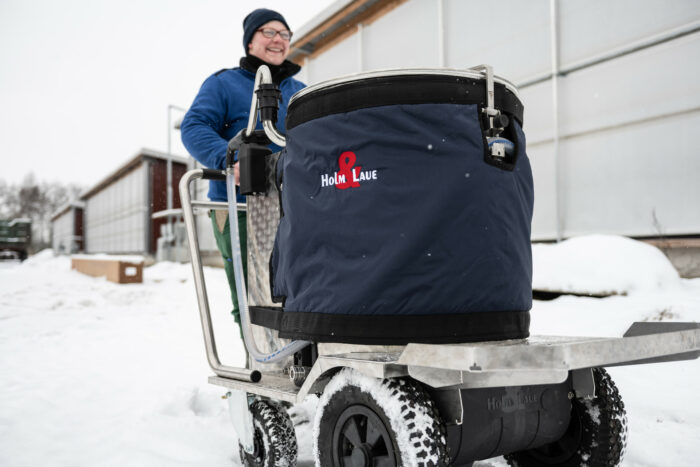
MilchTaxi-Mantel
An besonders kalten Tagen kühlt die Kälbermilch zwischen Erwärmen und Füttern schnell aus. Mit unserem neuen Mantel für das MilchTaxi bleibt sie nach eigenen Testversuchen ca. doppelt so lange warm wie ohne Mantel (im Versuch verlor die Milch ca. 1° C nach 8 Minuten ohne Mantel, aber erst nach ca. 17 Minuten mit Mantel).
Drenchen von Kühen
Optional ist eine Drenchfunktion für Kühe erhältlich. Im MilchTaxi kann die Drenchflüssigkeit optimal angerührt und temperiert, zu den Kühen gefahren und anschließend über die Pumpe in schonender Weise in den Pansen gedrencht werden. Statt sich mit einer manuellen Handpumpe abzumühen, können Sie sich mit dem MilchTaxi optimal auf die Kuh konzentrieren.
Lebensmittelzulassung
Optional kann das MilchTaxi mit Komponenten ausgestattet werden, die es erlauben Milch für die Lebensmittelnutzung zu transportieren. So kann Milch z.B. vom Melkstand zur Milch-Tankstelle oder Käserei gefahren werden. Bitte achten Sie hierbei auf die notwendigen Hygienerichtlinien.
Das große Anhängermodell für bis zu 100 Kälber
oder 800 Liter Tränke pro Tag (2 x 400 l).
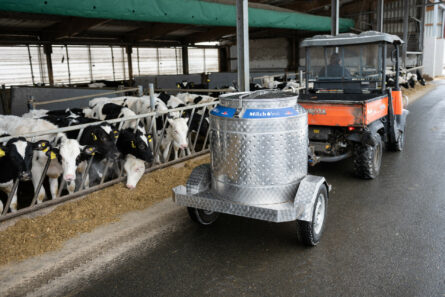
Manchmal reicht selbst das bisher größte MilchTaxi mit 260 l nicht aus. Das liegt nicht nur an den größer werdenden Betrieben, sondern auch daran, dass mehr Milch je Kalb verfüttert wird. Das 400 l MilchTaxi bietet nun auch größeren Betrieben fast alle Vorzüge, die die bewährten kleineren Modelle aufweisen. Sogar die Pasteurfunktion ist optional erhältlich, sodass auch beim 400er keine Wünsche offen bleiben.
Das MTX 400 ist nicht nur aufgrund seines höheren Nutzungsgewichtes besonders stabil gebaut. Die gefederte Achse sorgt besonders auf unebenen Wegen dafür, dass der Transport der Milch zu den Kälbern ruhig und geschmeidig abläuft.
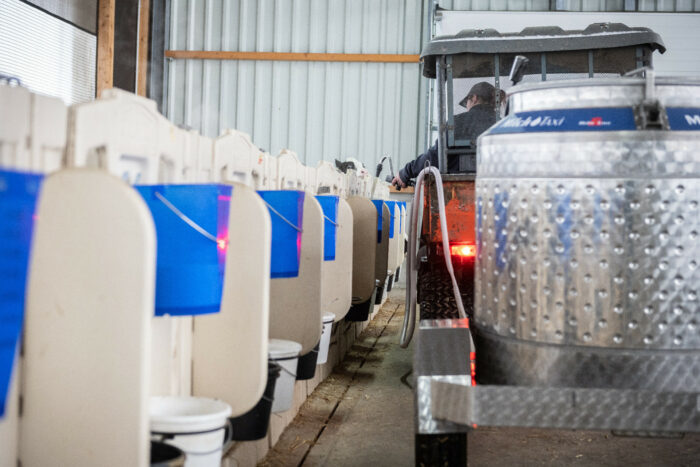
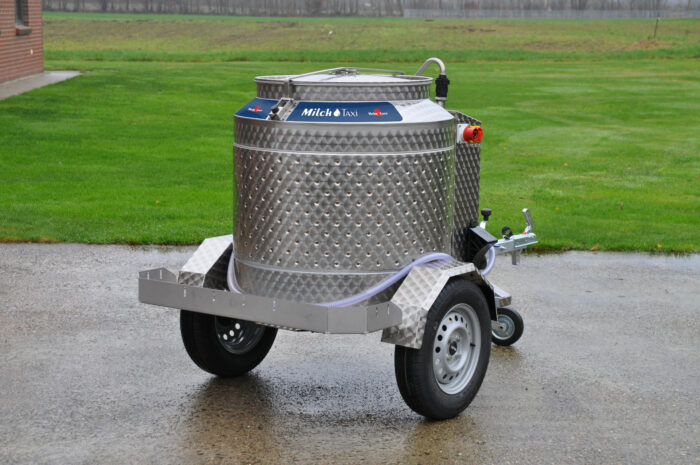
Sie haben bereits einen Milchtank? Nutzen Sie die Dosiereinheit des MilchTaxis, um Ihre Kälber bequem zu füttern.

Dosiereinheit
Wenn die bewährten MilchTaxi-Modelle nicht groß genug sein sollten, bietet die Dosiereinheit eine ideale Möglichkeit vorhandene Milchtanks zum XXL MilchTaxi umzubauen. Die Dosiereinheit besteht aus der batteriebetriebenen Pumpe mit Dosierarm. Display und Bedienung werden in einer separaten Einheit bequem in der Fahrerkabine des Fahrzeugs integriert. Dabei misst die Dosiereinheit zusätzlich die Milchtemperatur und bestimmt über den integrieren SmartMix Sensor die Füllmenge im Tank.
So können alle Betriebsgrößen die Vorzüge der genauen Dosierung und der optimalen Temperaturkontrolle beim Füttern ihrer Kälber nutzen. Machen Sie Ihren Tank zum MilchTaxi XXL!
Der Tank und das Fahrzeug sind KEINE Bestandteile der Dosiereinheit! Diese Option beinhaltet auch kein Rührwerk oder Pasteurfunktion.
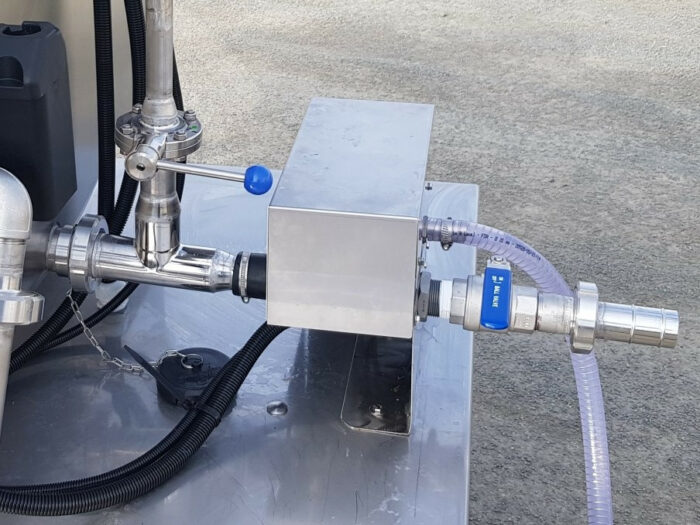
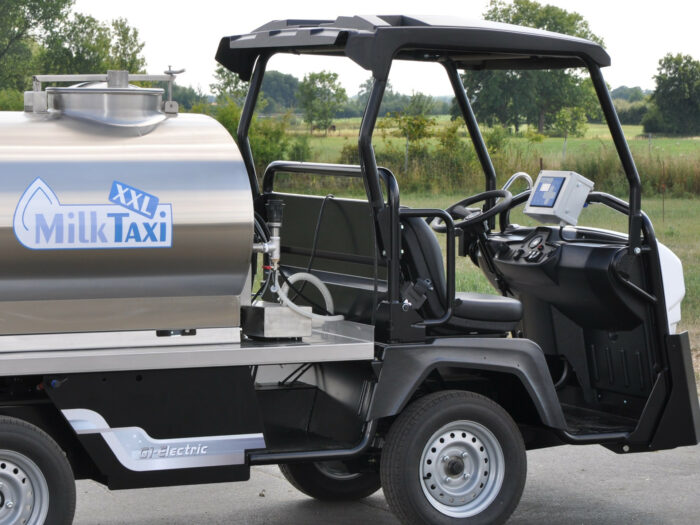
Technische Daten und Abmessungen
| MilchTaxi 100 l | MilchTaxi 150 l | MilchTaxi 260 l | MilchTaxi 260 l Anhänger | MilchTaxi 400 l Anhänger | |||
|---|---|---|---|---|---|---|---|
| Nutzbarer Tankinhalt | 100 l | 150 l | 260 l | 260 l | 400 l | ||
| Tatsächlicher Tankinhalt | 115 l | 180 l | 290 l | 290 l | 480 l | ||
| Breite (cm) | 62 | 78 | 78 | 120 | 130 | ||
| Länge (cm) | 118 | 127 | 127 | 172 | 220 | ||
| Höhe (cm) | 120 | 120 | 135 | 135 | 140 | ||
| Netzanschluss | 230 V / 16 A | 400 V / 16 A | 400 V / 16 A | 400 V /16 A | 400 V /16 A | ||
| Pumpenleistung | ca. 40 l / Min. | ca. 40 l / Min. | ca. 40 l / Min. | ca. 40 l / Min. | ca. 40 l / Min. | ||
| Heizleistung | 3 kW | 5 kW | 6 kW | 6 kW | 9,7 kW | ||
| Rührwerk | 250 W | 250 W | 250 W | 250 W | 250 W | ||
| Reifengröße | 400 / 250 mm | 400 / 250 mm | 400 / 250 mm | 400 mm | 570 mm |
Ausstattung und Optionen
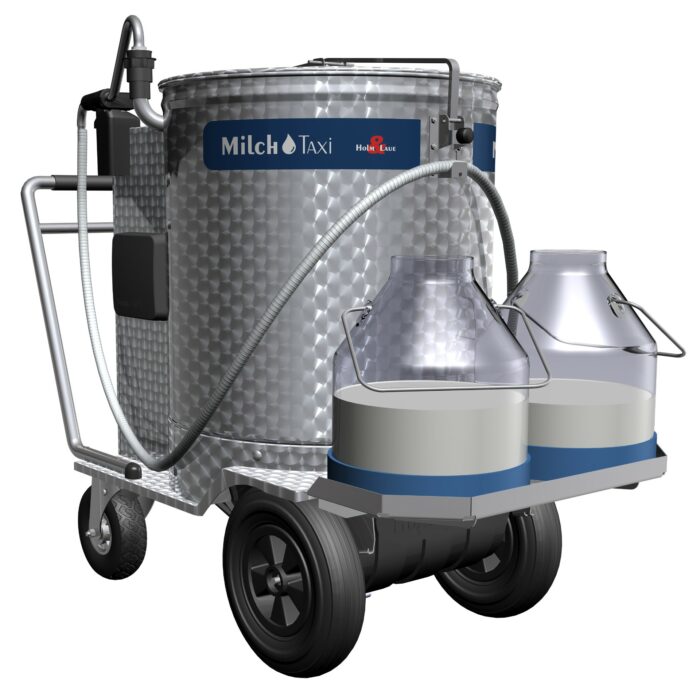
Grundausstattung MilchTaxi ohne Pasteurfunktion
- Stabiles und wendiges Fahrwerk auf 4 Rädern (Typen 100 l, 150 l, 260 l), Vorderreifen: 40 cm Durchmesser
- Elektronische Steuerung mit Füllstandskontrolle, Thermometer und Statistikfunktion
- Kraftvolles Bodenrührwerk, schonendes Intervallrühren beim Erwärmen der Milch
- Tank aus poliertem Edelstahl, leicht zu reinigen
- Verschließbarer Deckel mit Dichtung, vollständig zu öffnen
- 1 ¼″ Auslaufhahn zur vollständigen Entleerung
- LED-Fahrlicht
- Halbautomatisches Reinigungsprogramm
Zusatzausstattung MilchTaxi ohne Pasteurfunktion
- Schonende Flächenheizung
- Pumpe mit Dosierarm
- Kabellose Funkfernbedienung am Dosierarm
- EL-AN Elektrischer Fahrantrieb
- HeavyGrip Bereifung
- Pannensichere Reifen
- SmartMix
- SmartID (nicht erhältlich bei Anhängermodellen)
- Klappbarer Eimerhalterahmen für zwei 30 l Milchkannen
- Kolostrumbehälter
- SpotLight Arbeitsscheinwerfer
- FlushMaster Eimerreinigung
- Handschuhfach
- Drenchfunktion für Kühe
- FoodSafe Lebensmittelzulassung
- CalfGuide für MilchTaxi
- MilchTaxi-Mantel zur Wärmedämmung
- AutomaticMilkSupply
- EcoHub
- EcoHubAMS
- PlusTank
Grundausstattung MilchTaxi Pasteur
- Stabiles und wendiges Fahrwerk auf 4 Rädern (Typen 100 l, 150 l, 260 l), Vorderreifen: 40 cm Durchmesser
- Elektronische Steuerung mit Füllstandskontrolle, Thermometer und Statistikfunktion
- Kraftvolles Bodenrührwerk, schonendes Intervallrühren beim Erwärmen der Milch
- Schonende Flächenheizung
- Pumpe mit Dosierarm
- Tank aus poliertem Edelstahl, leicht zu reinigen
- Verschließbarer Deckel mit Dichtung, vollständig zu öffnen
- 1 ¼″ Auslaufhahn zur vollständigen Entleerung
- LED Fahrlicht
- Halbautomatisches Reinigungsprogramm
Zusatzausstattung MilchTaxi Pasteur
- Kabellose Funkfernbedienung am Dosierarm
- EL-AN Elektrischer Fahrantrieb
- HeavyGrip Bereifung
- Pannensichere Reifen
- SmartMix
- SmartID
- Klappbarer Eimerhalterahmen für zwei 30 l Milchkannen
- Kolostrumbehälter
- SpotLight Arbeitsscheinwerfer
- FlushMaster Eimerreinigung
- Handschuhfach
- Drenchfunktion für Kühe
- FoodSafe Lebensmittelzulassung
- CalfGuide für MilchTaxi
- MilchTaxi-Mantel zur Wärmedämmung
- AutomaticMilkSupply
- EcoHub
- EcoHub AMS
- PlusTank

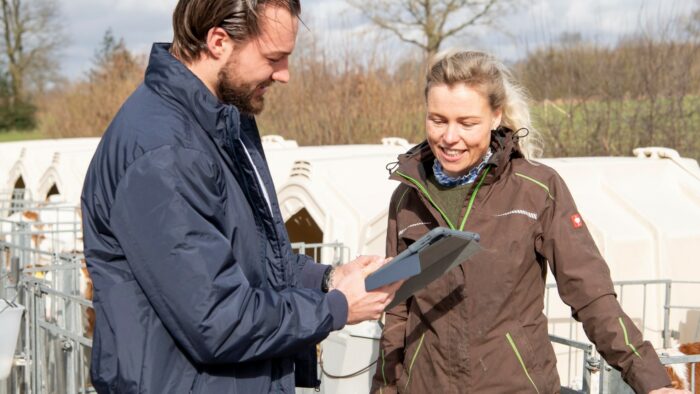


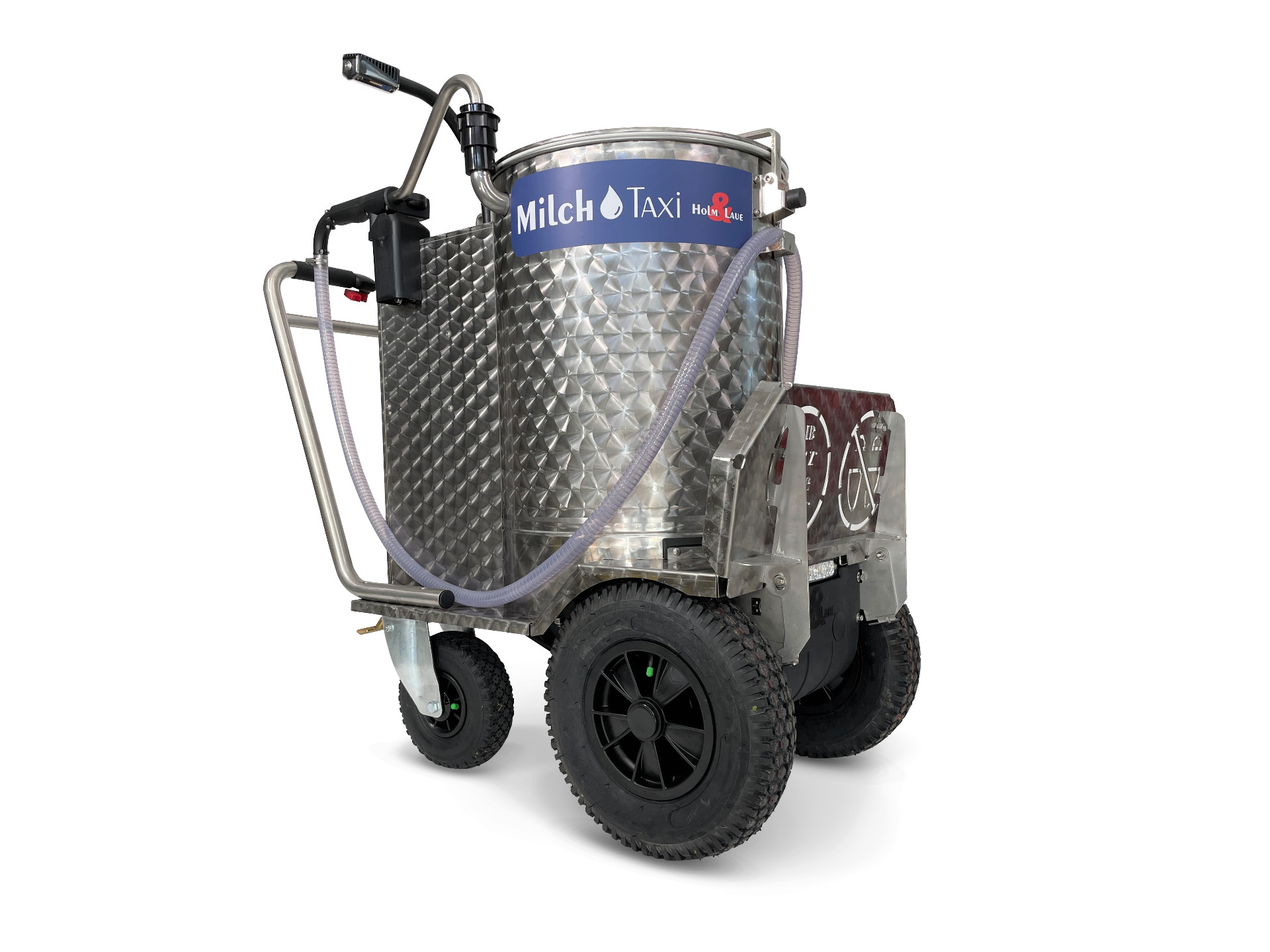

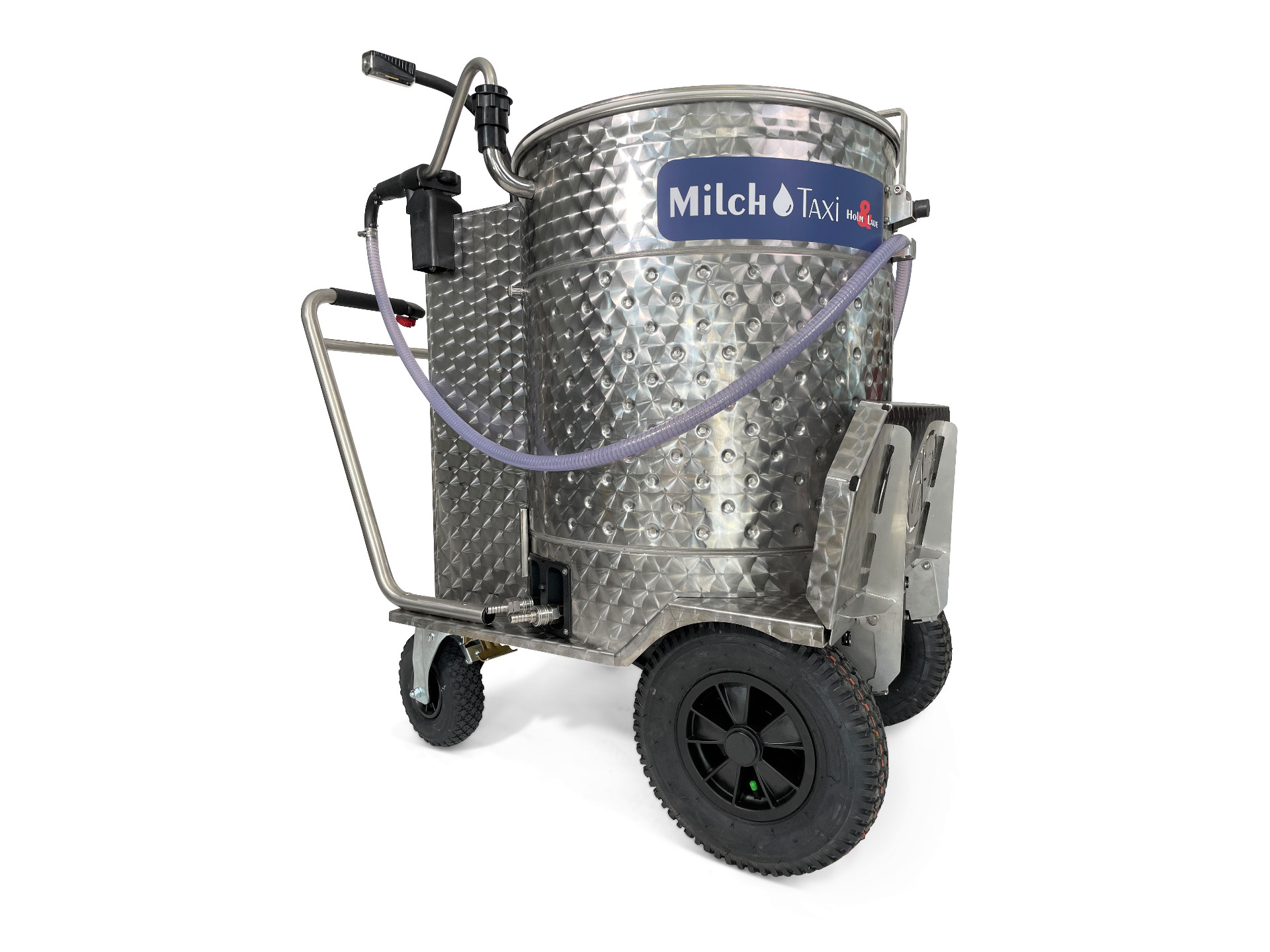
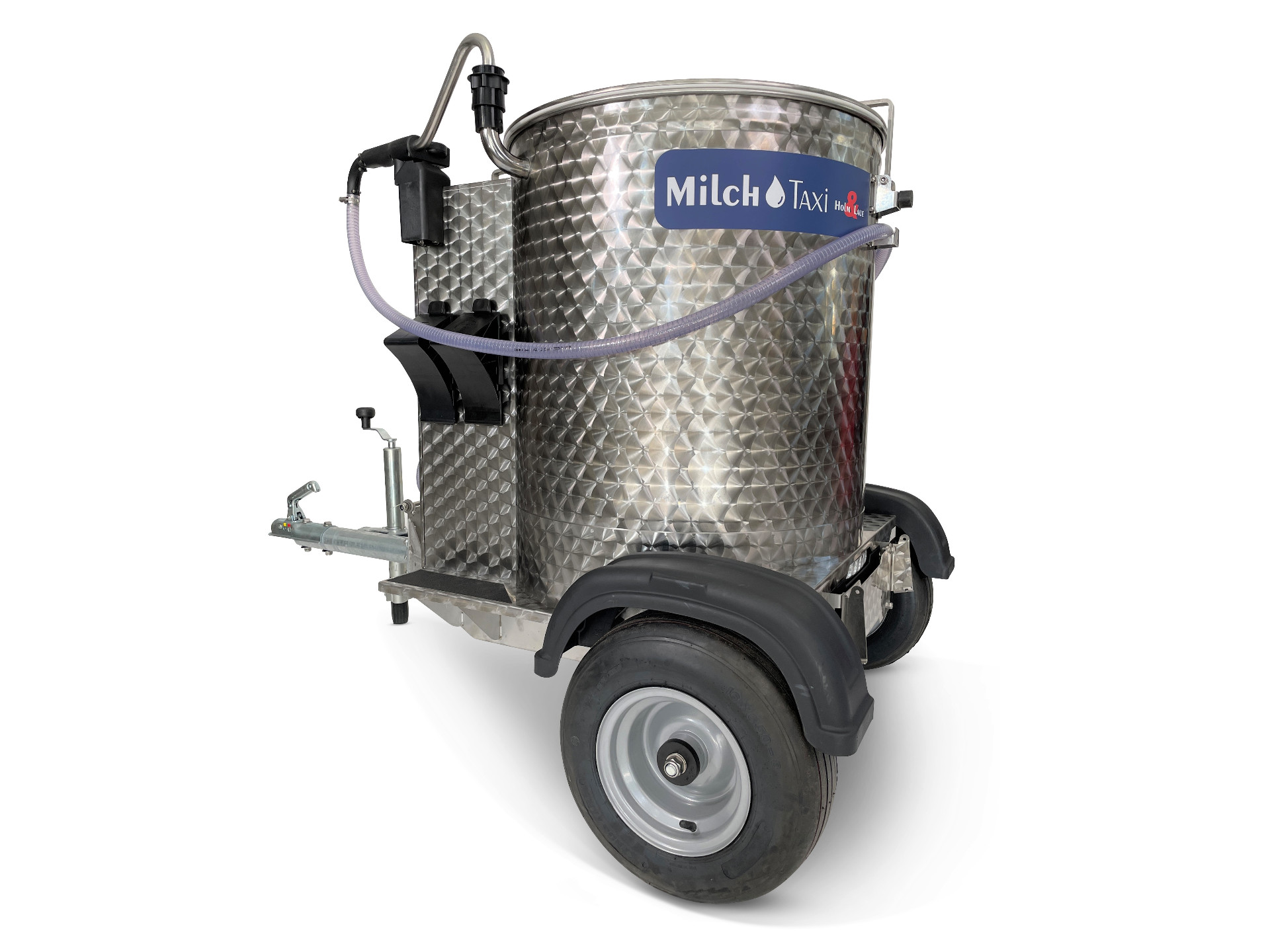
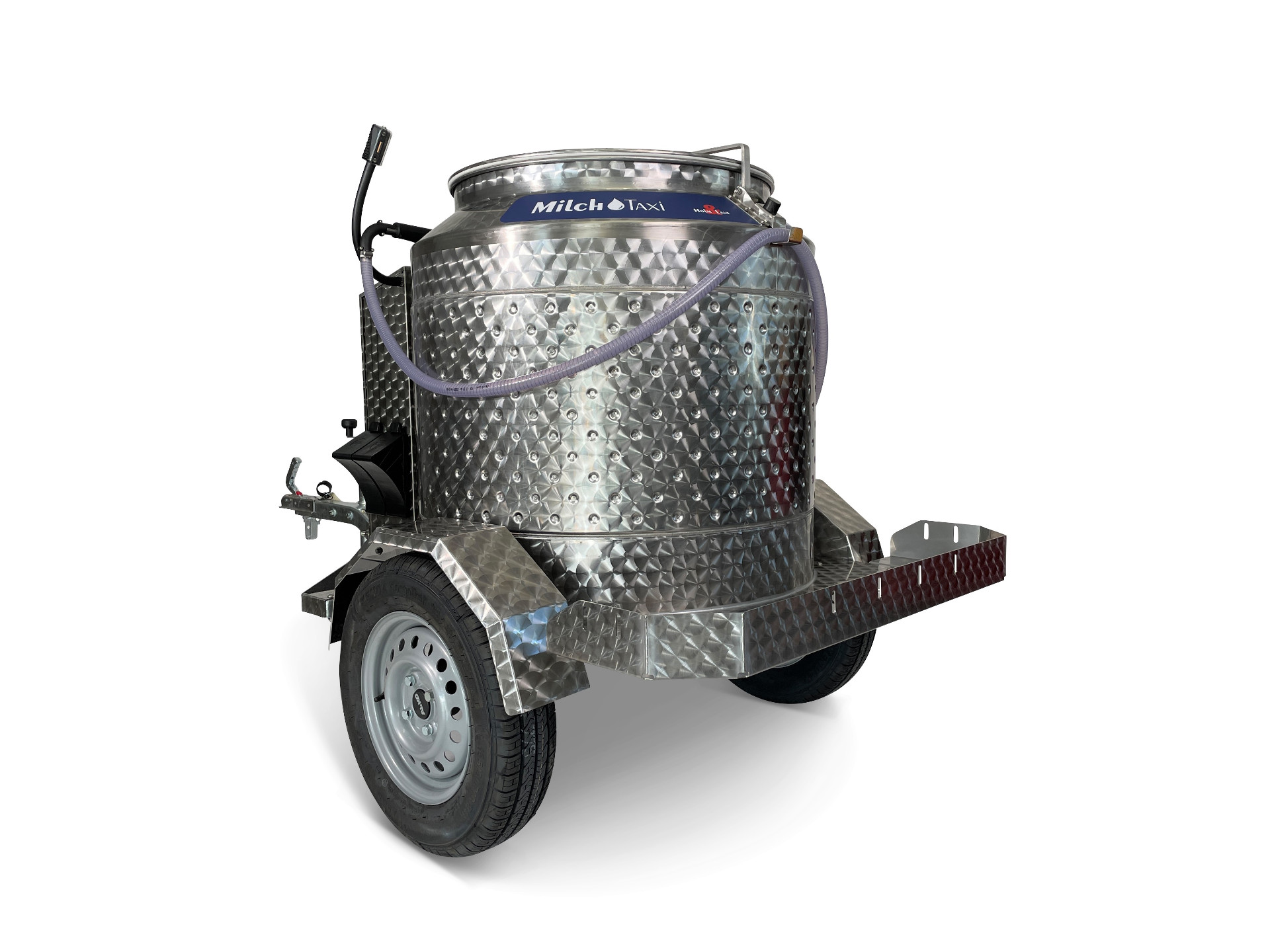
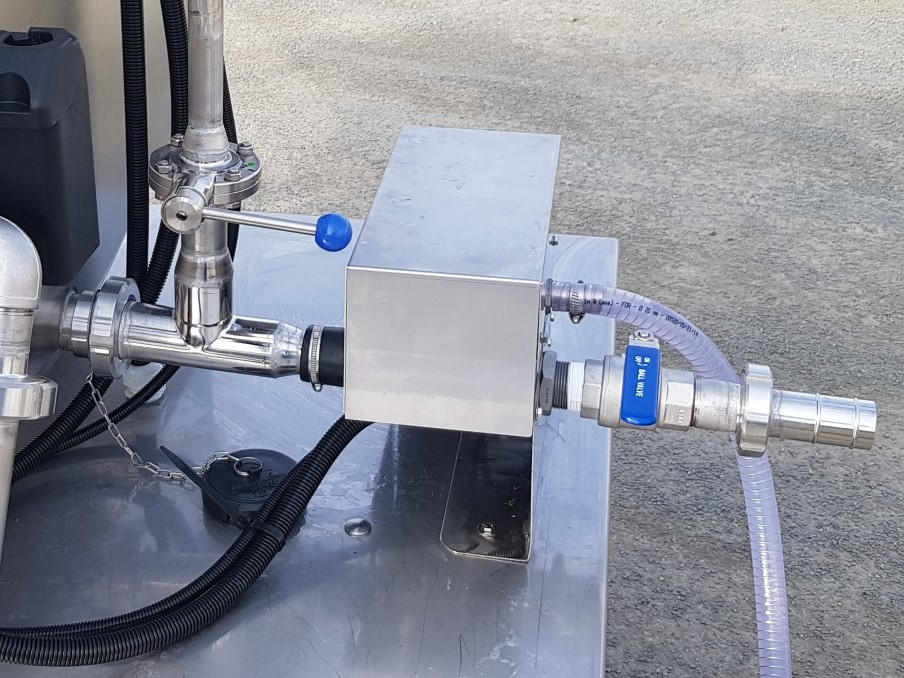 Pumpeneinheit (kann bauartbedingt abweichen)
Pumpeneinheit (kann bauartbedingt abweichen)
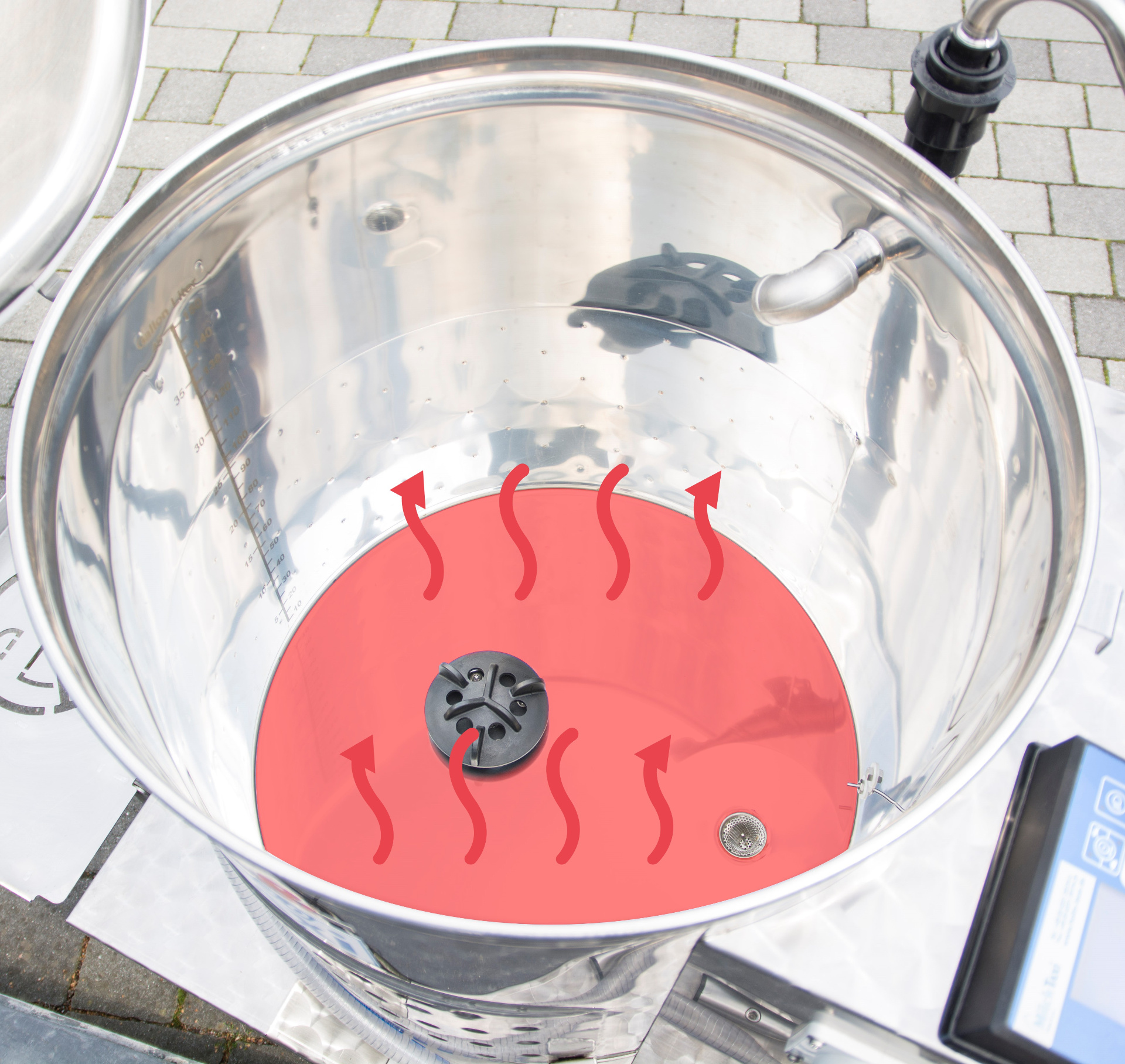
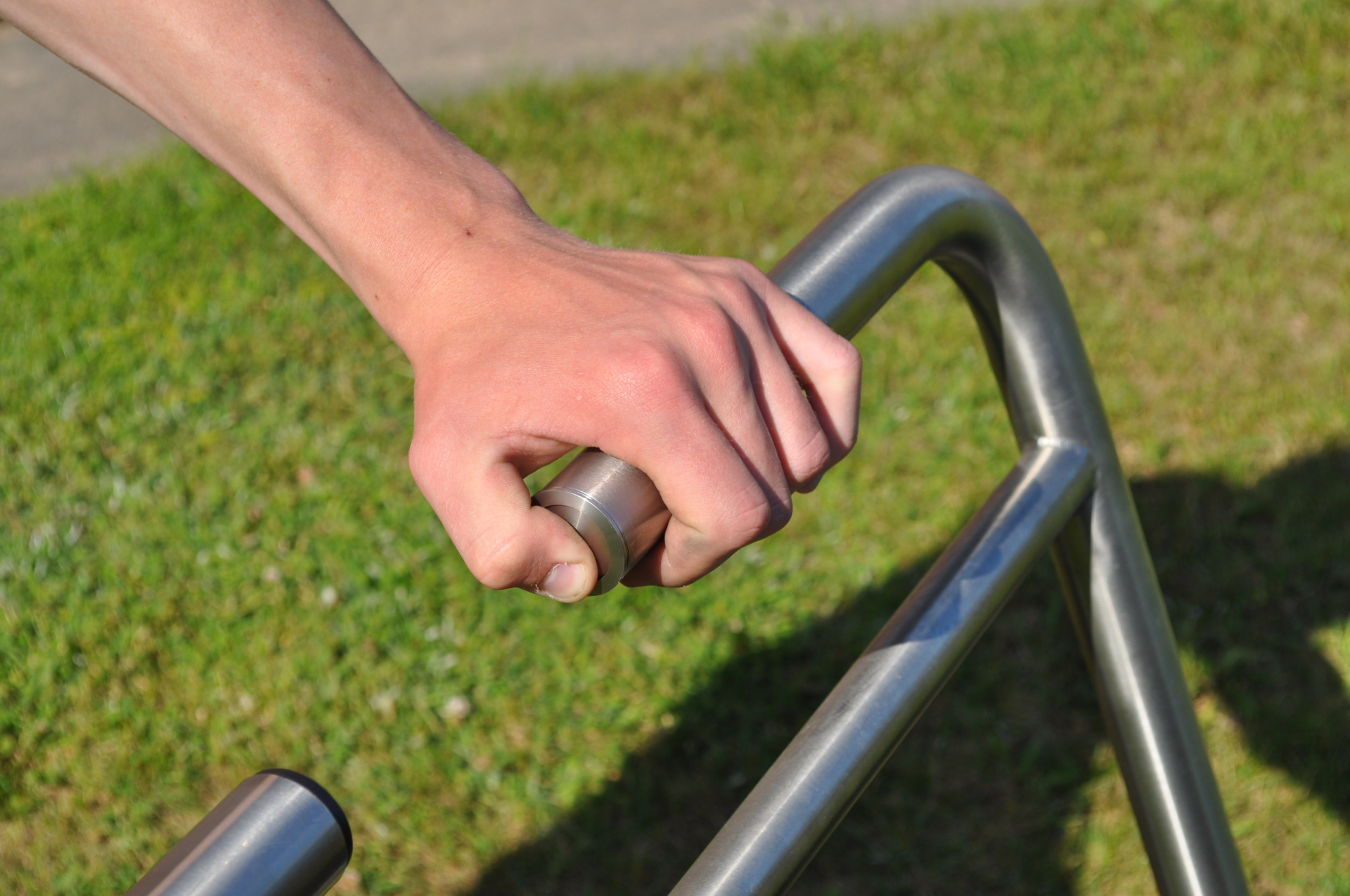
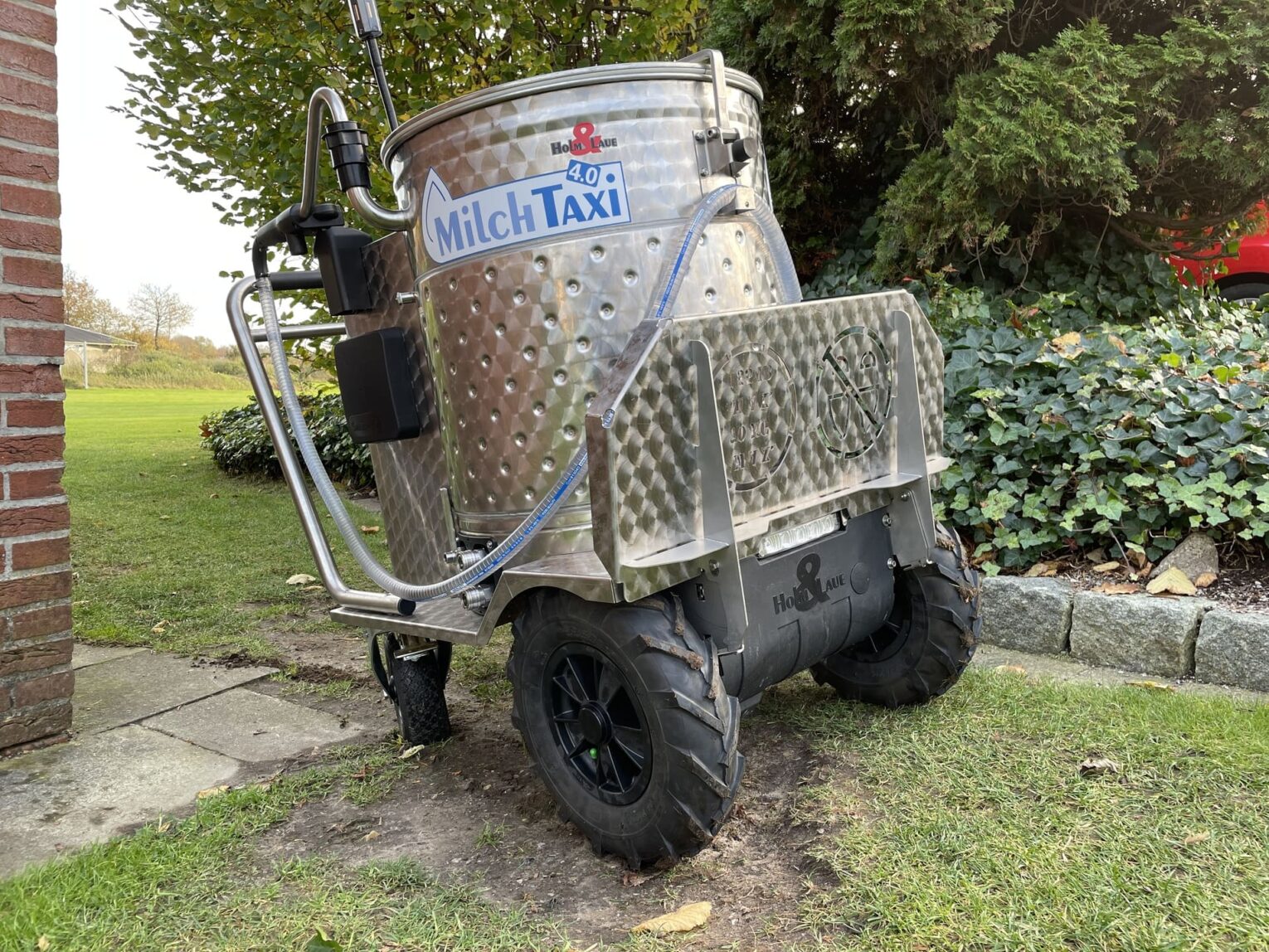
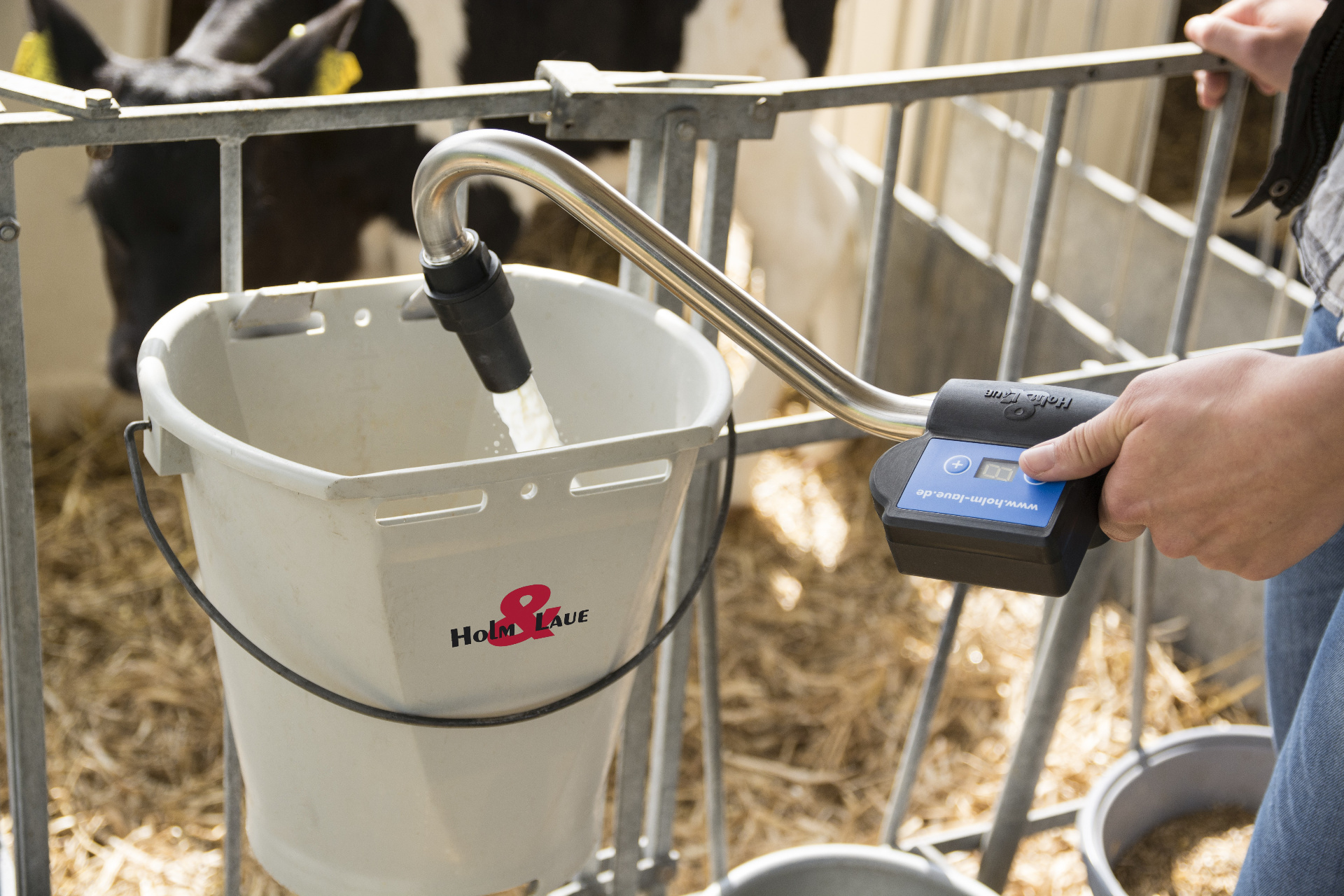
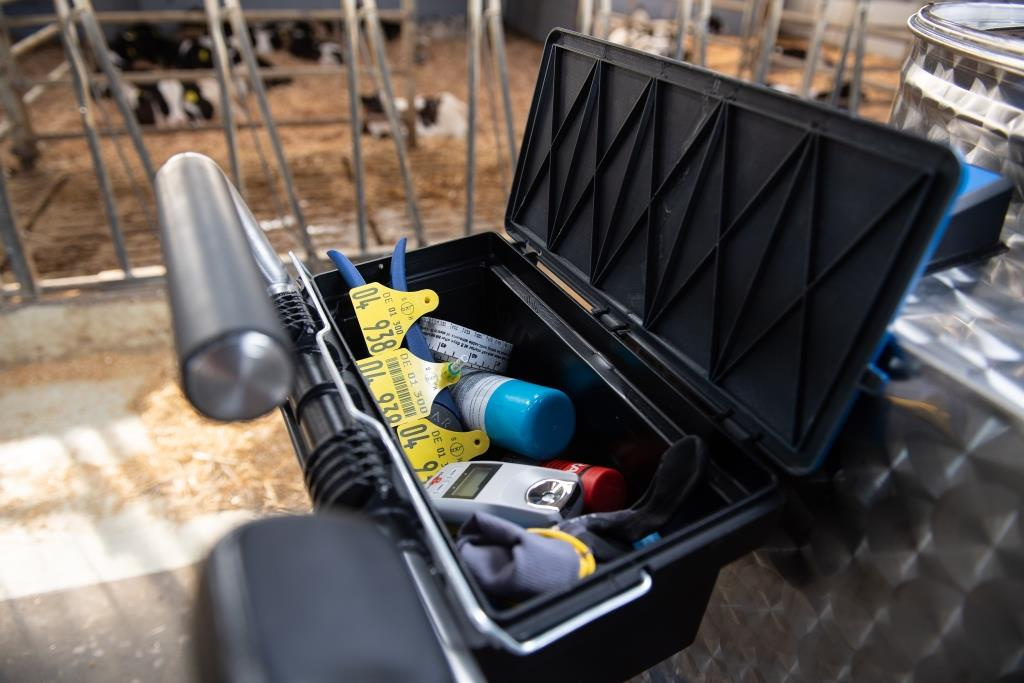
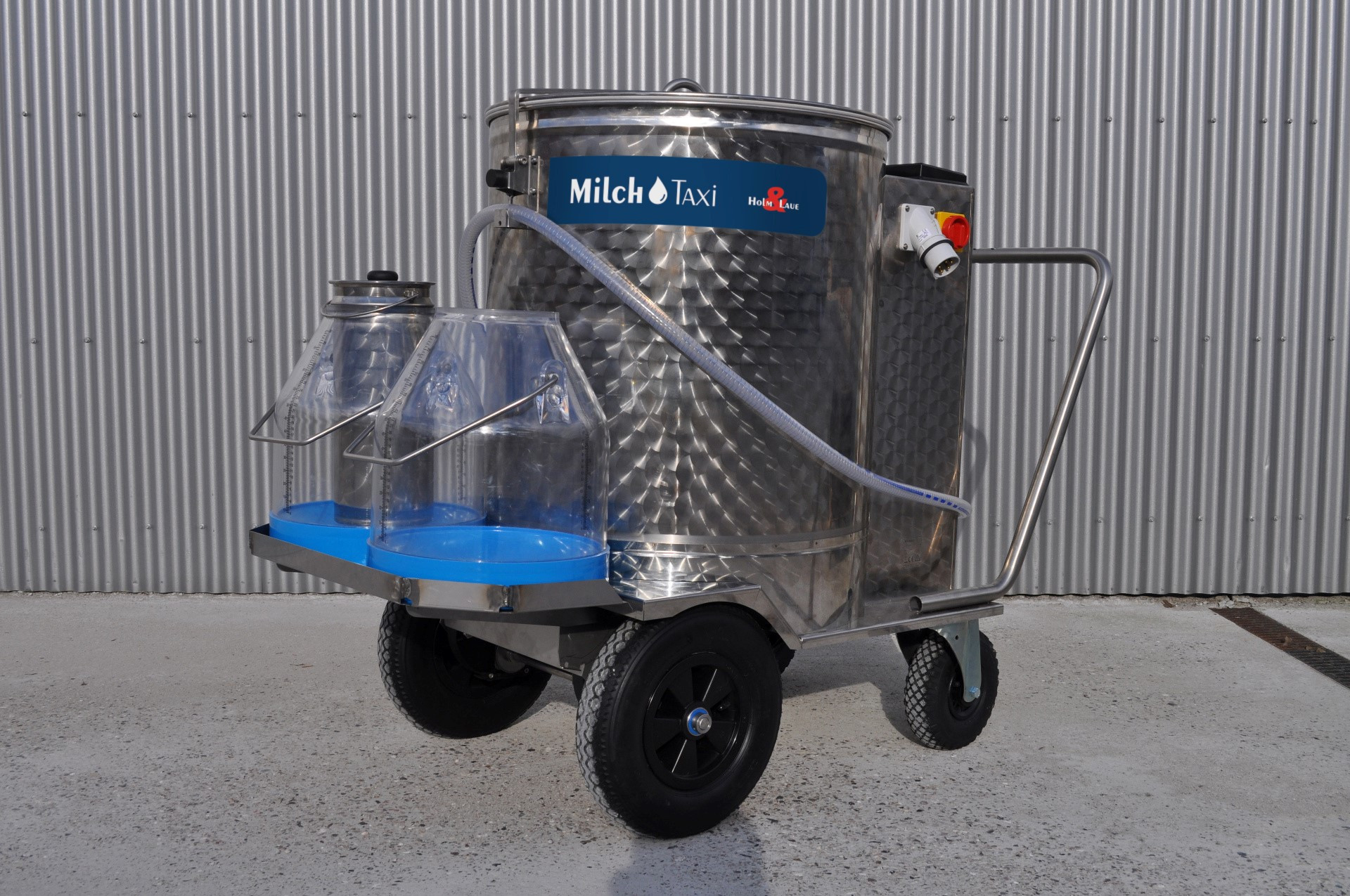
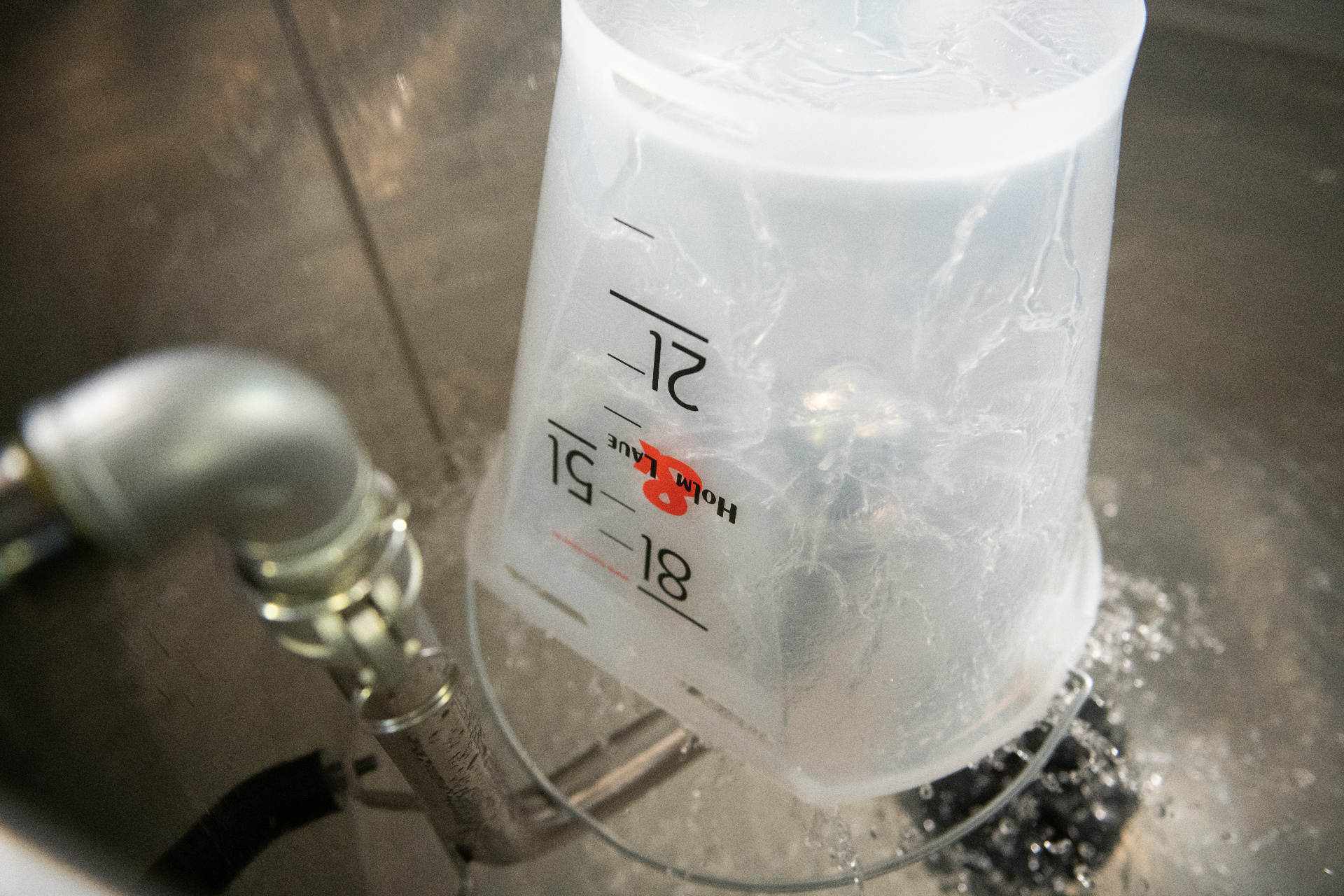
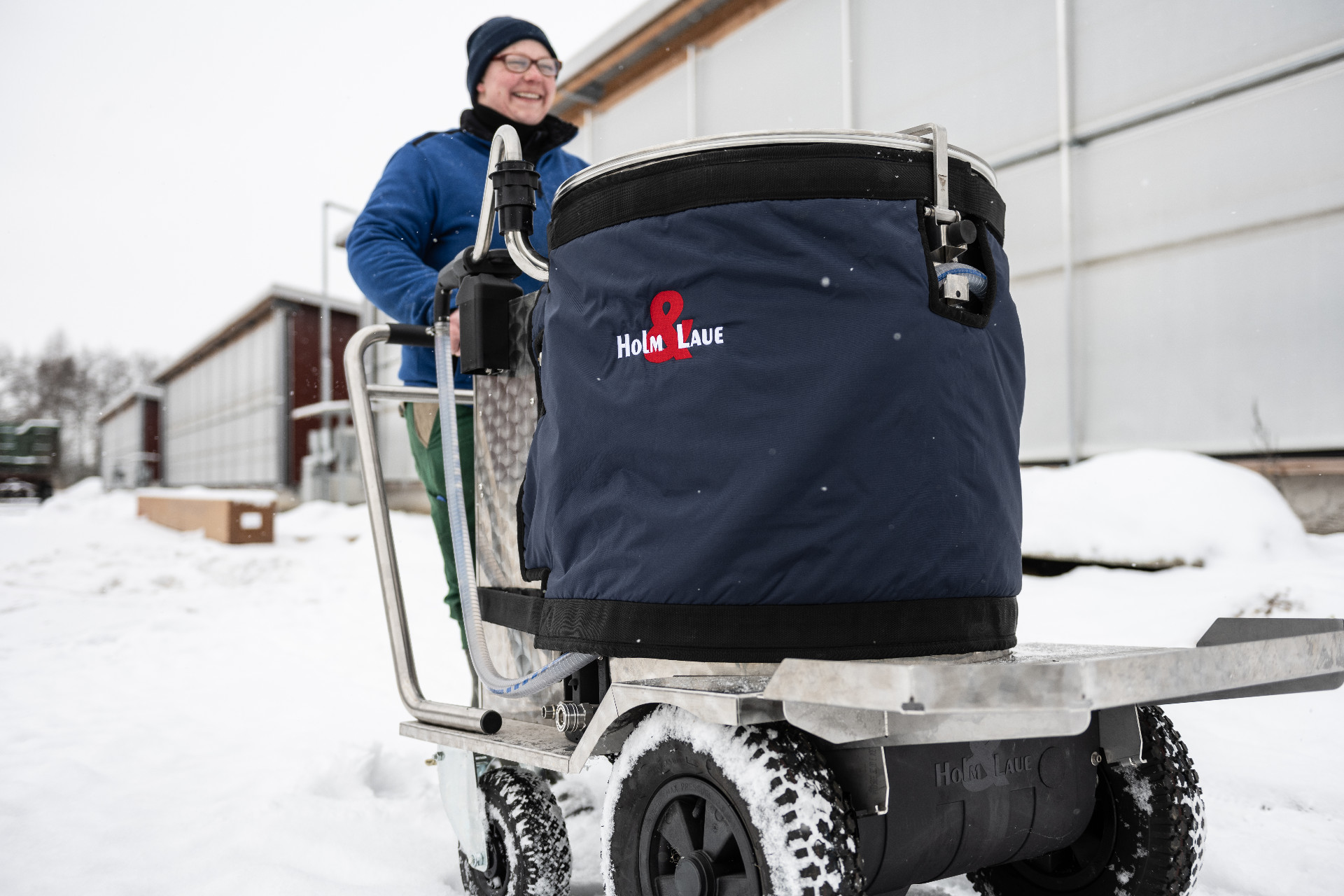
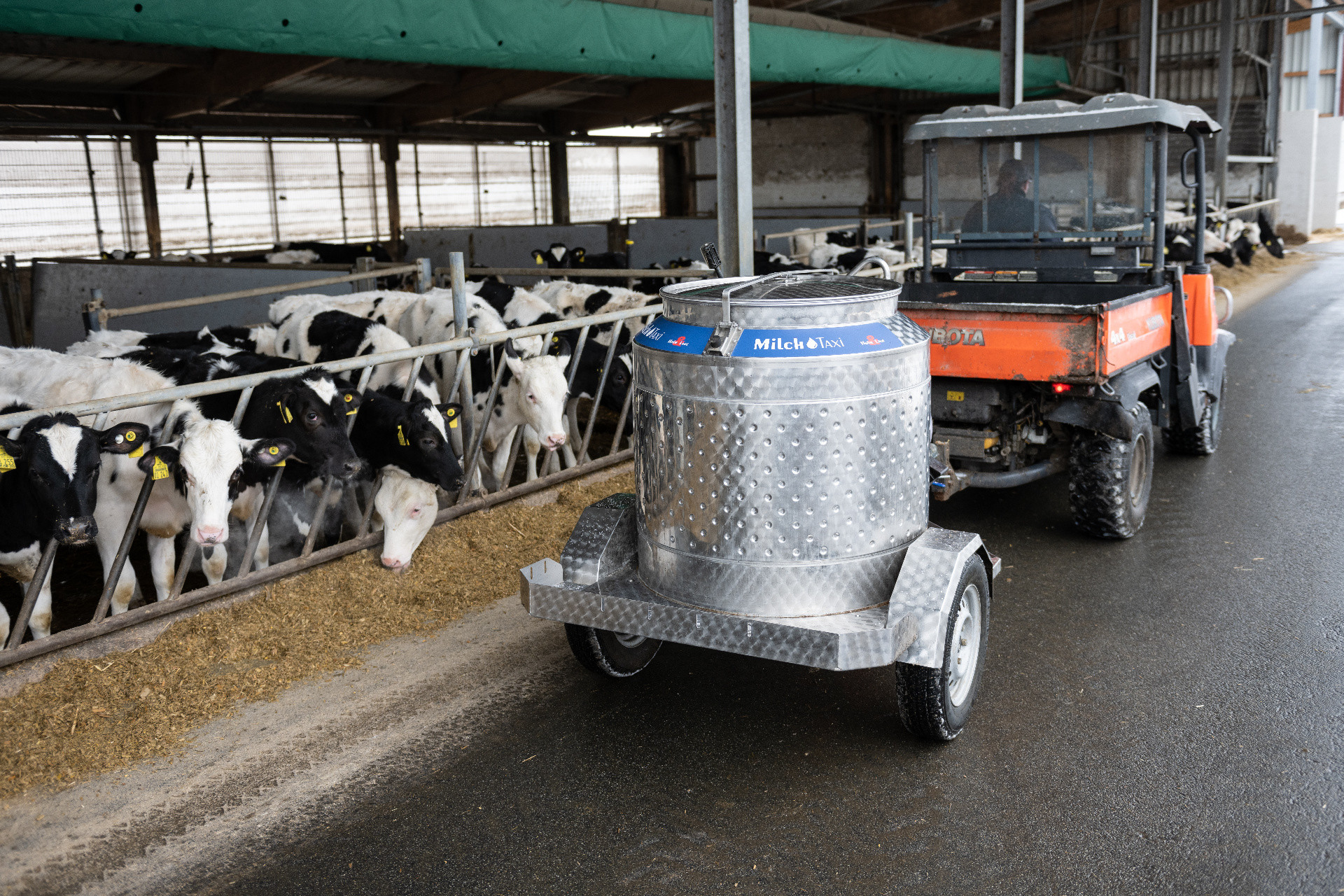
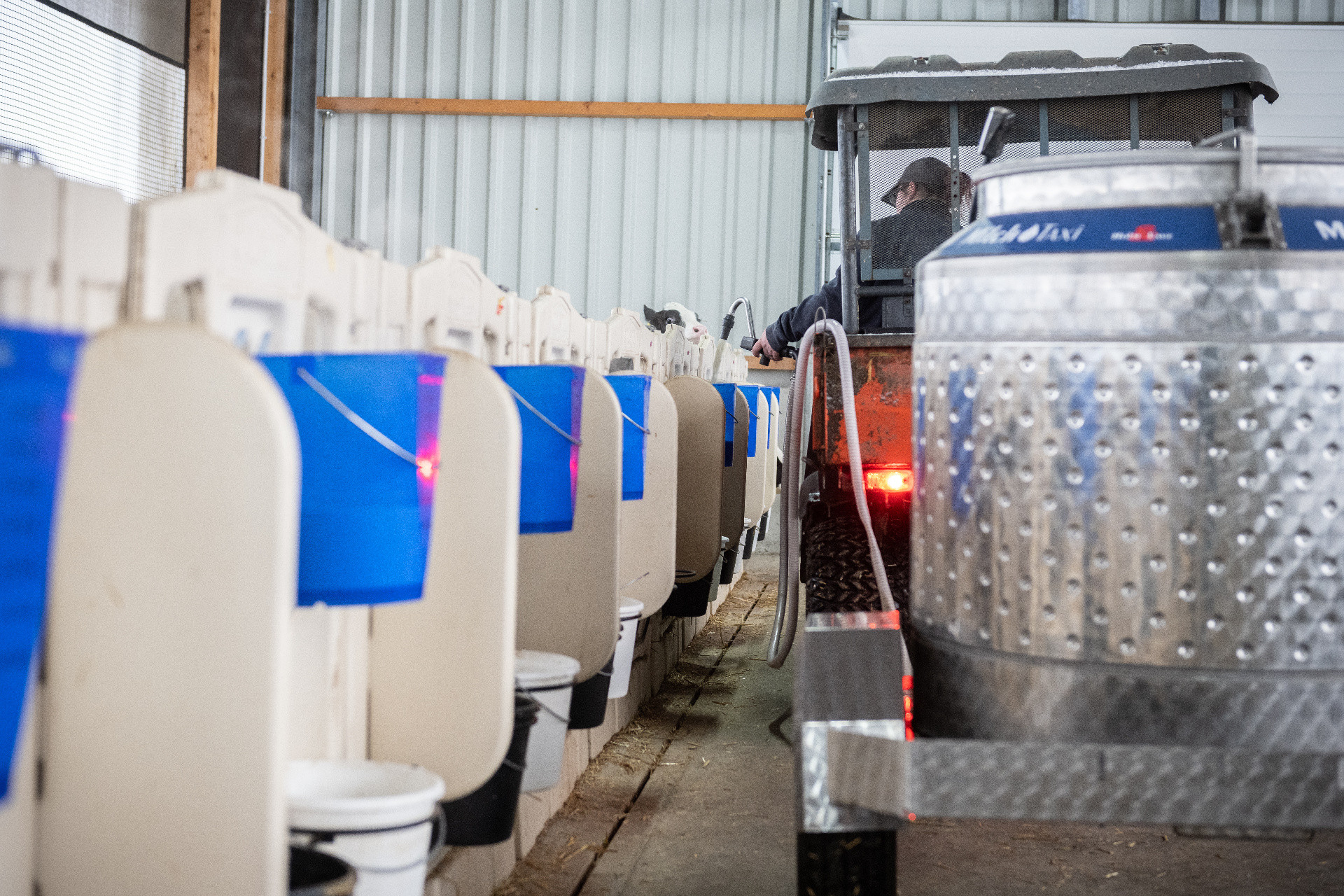 Ausdosieren mit dem MilchTaxi 400 Liter
Ausdosieren mit dem MilchTaxi 400 Liter
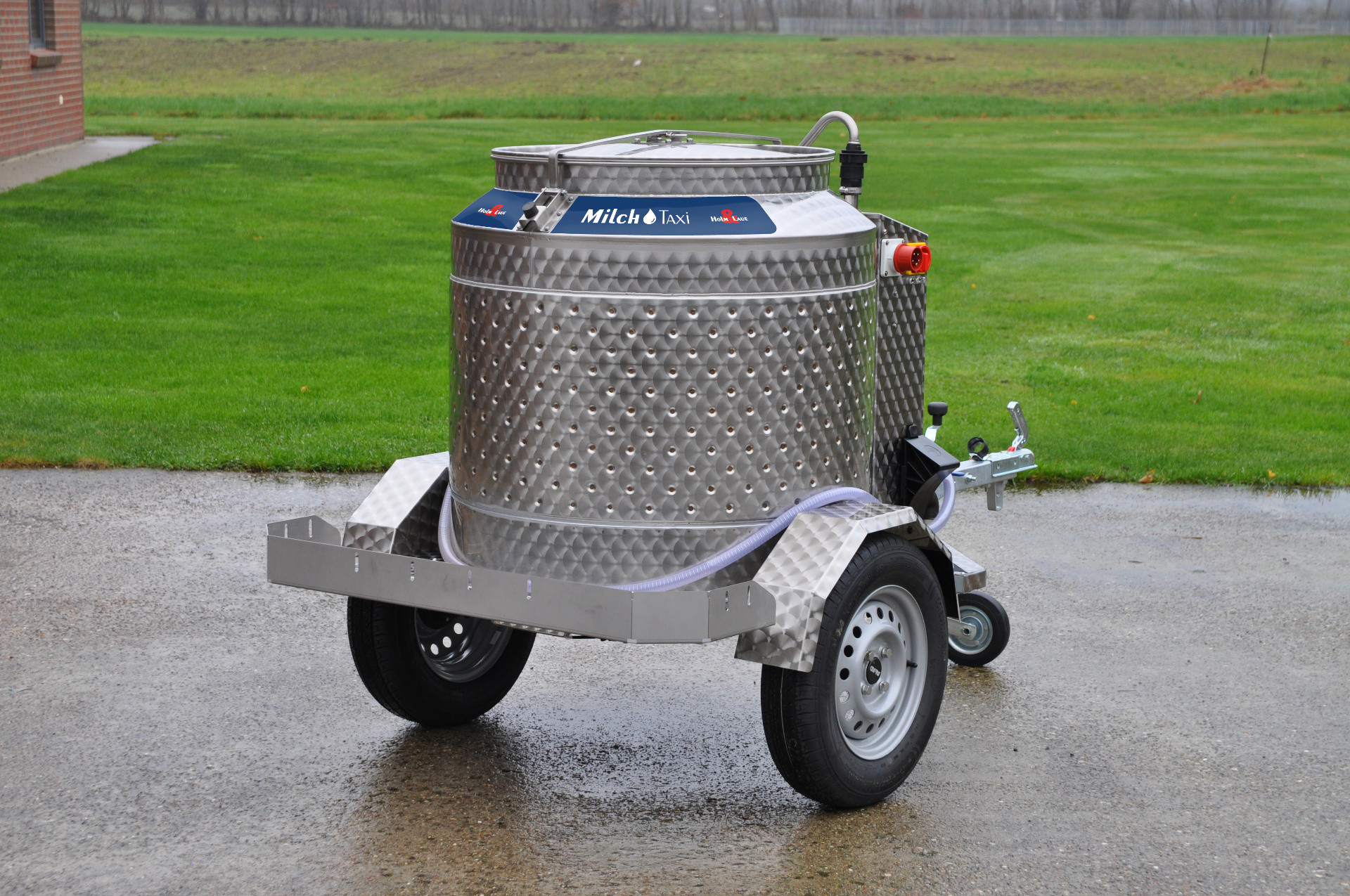 Das Anhängermodell mit Milchkannenhalterahmen
Das Anhängermodell mit Milchkannenhalterahmen
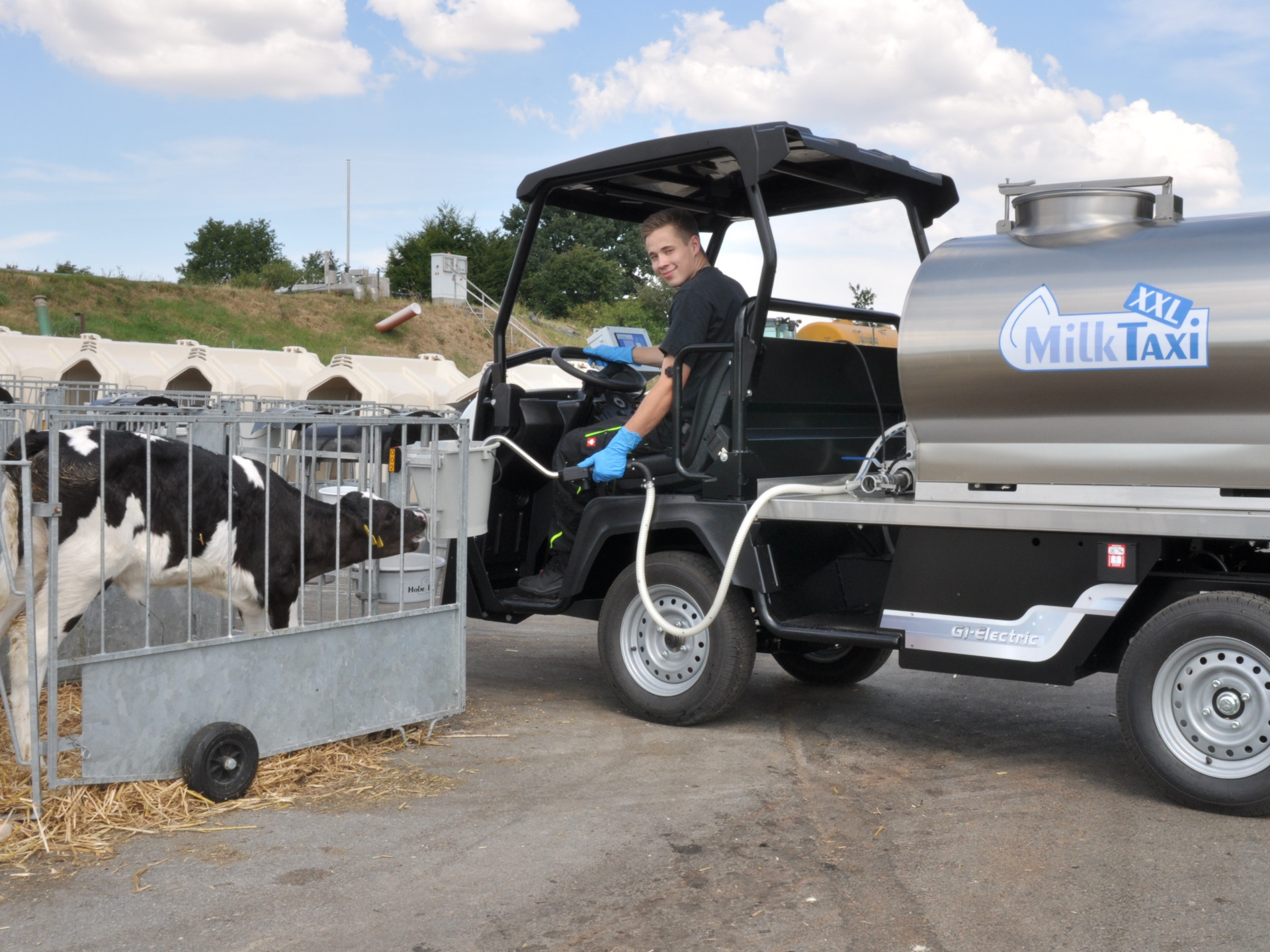
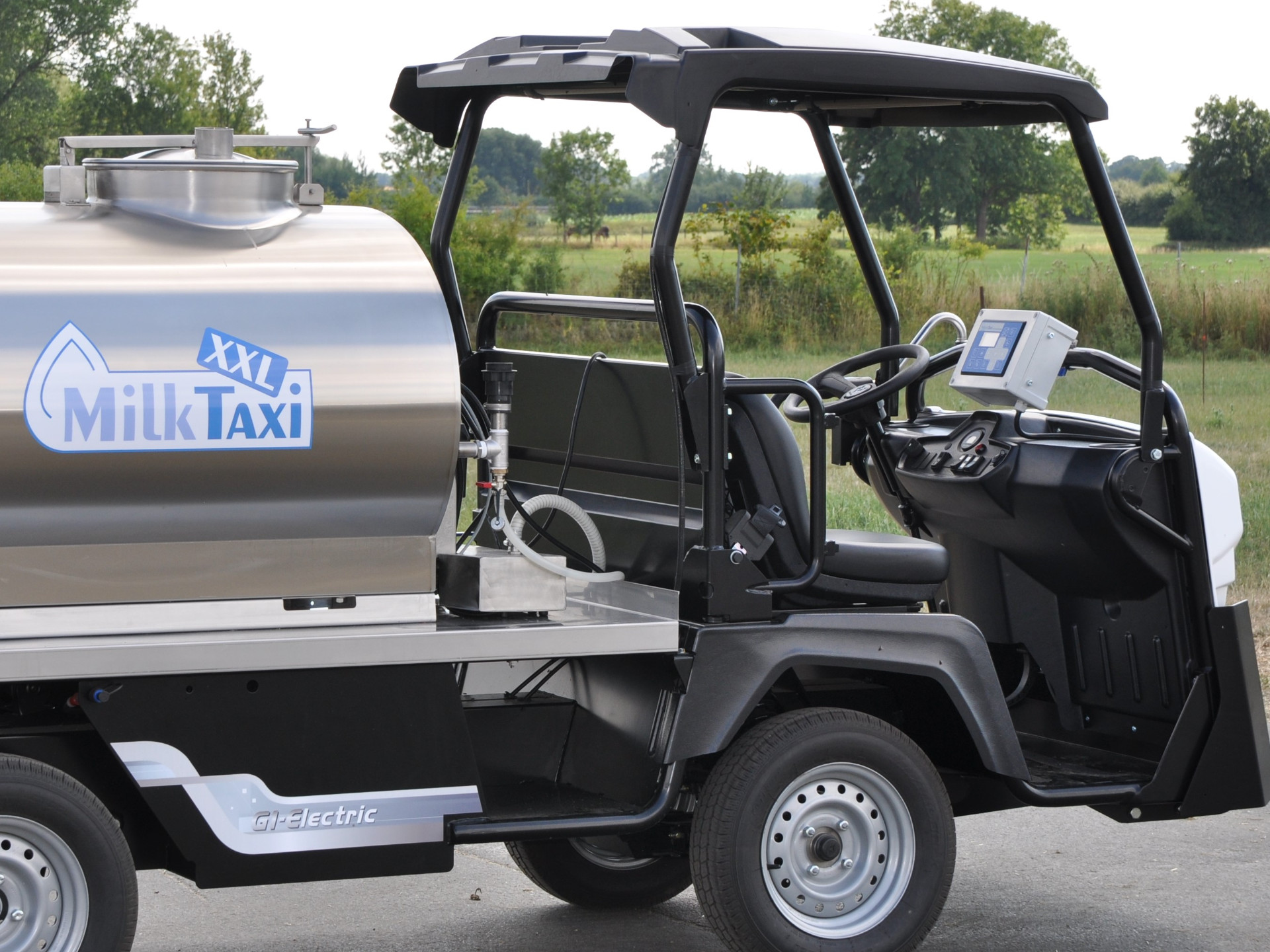 Bedienenheit in Fahrerkabine (kann bauartbedingt abweichen)
Bedienenheit in Fahrerkabine (kann bauartbedingt abweichen)
